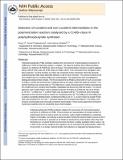| dc.contributor.author | Li, Ping | |
| dc.contributor.author | Chakraborty, Sumit | |
| dc.contributor.author | Stubbe, JoAnne | |
| dc.date.accessioned | 2013-11-22T19:35:06Z | |
| dc.date.available | 2013-11-22T19:35:06Z | |
| dc.date.issued | 2009-08 | |
| dc.date.submitted | 2009-08 | |
| dc.identifier.issn | 0006-2960 | |
| dc.identifier.issn | 1520-4995 | |
| dc.identifier.uri | http://hdl.handle.net/1721.1/82557 | |
| dc.description.abstract | Polyhydroxybutyrate (PHB) synthases catalyze the conversion of 3-hydroxybutyryl coenzyme A (HBCoA) to PHB with a molecular mass of 1.5 MDa. The class III synthase from Allochromatium vinosum is a tetramer of PhaEPhaC (each 40 kDa). The polymerization involves covalent catalysis using C149 of PhaC with one PHB chain per PhaEC dimer. Two mechanisms for elongation have been proposed. The first involves an active site composed of two monomers in which the growing hydroxybutyrate (HB) chain alternates between C149 on each monomer. The second involves C149 and covalent and noncovalent (HB)[subscript n]CoA intermediates. Two approaches were investigated to distinguish between these models. The first involved the wild-type (wt) PhaEC primed with sTCoA [a CoA ester of (HB)[subscript 3] in which the terminal HO group is replaced with an H] which uniformly loads the enzyme. The primed synthase was reacted with [1-[superscript 14]C]HBCoA by a rapid chemical quench method and analyzed for covalent and noncovalent intermediates. Radiolabel was found only with the protein. The second approach used C149S-PhaEC which catalyzes polymer formation at 1/2200 of the rate of wt-PhaEC (1.79 min[superscript −1] vs 3900 min[superscript −1]). C149S-PhaEC was incubated with [1-[superscript 14]C]HBCoA and chemically quenched on the minute time scale to reveal noncovalently bound [1-[superscript 14]C](HB)[subscript 2]CoA and (HB)[subscript 3]CoA as well as covalently labeled protein. Synthesized (HB)[subscript n]CoA (n = 2 or 3) was shown to acylate PhaEC with rate constants of 1−2 min[superscript −1], and these species were converted into polymer. Thus, the (HB)[subscript n]CoA analogues function as kinetically and chemically competent intermediates. These results support the mechanism involving covalently and noncovalently bound intermediates. | en_US |
| dc.description.sponsorship | National Institutes of Health (U.S.) (Grant GM49171) | en_US |
| dc.description.sponsorship | National Institutes of Health (U.S.). Ruth L. Kirschstein National Research Service Award (Postdoctoral Fellowship F32GM082067) | en_US |
| dc.language.iso | en_US | |
| dc.publisher | American Chemical Society (ACS) | en_US |
| dc.relation.isversionof | http://dx.doi.org/10.1021/bi901329b | en_US |
| dc.rights | Article is made available in accordance with the publisher's policy and may be subject to US copyright law. Please refer to the publisher's site for terms of use. | en_US |
| dc.source | PMC | en_US |
| dc.title | Detection of Covalent and Noncovalent Intermediates in the Polymerization Reaction Catalyzed by a C149S Class III Polyhydroxybutyrate Synthase | en_US |
| dc.type | Article | en_US |
| dc.identifier.citation | Li, Ping, Sumit Chakraborty, and JoAnne Stubbe. “Detection of Covalent and Noncovalent Intermediates in the Polymerization Reaction Catalyzed by a C149S Class III Polyhydroxybutyrate Synthase.” Biochemistry 48, no. 39 (October 6, 2009): 9202-9211. | en_US |
| dc.contributor.department | Massachusetts Institute of Technology. Department of Biology | en_US |
| dc.contributor.department | Massachusetts Institute of Technology. Department of Chemistry | en_US |
| dc.contributor.mitauthor | Li, Ping | en_US |
| dc.contributor.mitauthor | Chakraborty, Sumit | en_US |
| dc.contributor.mitauthor | Stubbe, JoAnne | en_US |
| dc.relation.journal | Biochemistry | en_US |
| dc.eprint.version | Author's final manuscript | en_US |
| dc.type.uri | http://purl.org/eprint/type/JournalArticle | en_US |
| eprint.status | http://purl.org/eprint/status/PeerReviewed | en_US |
| dspace.orderedauthors | Li, Ping; Chakraborty, Sumit; Stubbe, JoAnne | en_US |
| dc.identifier.orcid | https://orcid.org/0000-0001-8076-4489 | |
| mit.license | PUBLISHER_POLICY | en_US |
| mit.metadata.status | Complete | |
